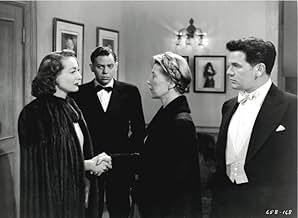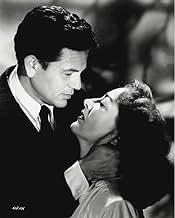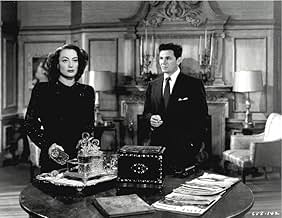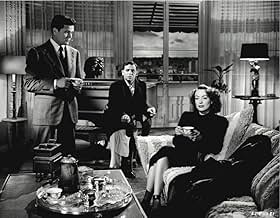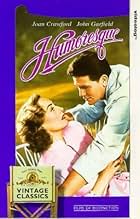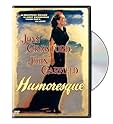IMDb-BEWERTUNG
7,3/10
5186
IHRE BEWERTUNG
Füge eine Handlung in deiner Sprache hinzuA classical musician from the slums is sidetracked by his love for a wealthy, neurotic socialite.A classical musician from the slums is sidetracked by his love for a wealthy, neurotic socialite.A classical musician from the slums is sidetracked by his love for a wealthy, neurotic socialite.
- Regie
- Drehbuch
- Hauptbesetzung
- Für 1 Oscar nominiert
- 4 Gewinne & 1 Nominierung insgesamt
Robert Blake
- Paul Boray (as a Child)
- (as Bobby Blake)
Peg La Centra
- Night Club Singer
- (as Peg LaCentra)
Empfohlene Bewertungen
The film is over 2 hours long, but Crawford only has about 1 hour of film time in it, and it is surely one of her finest performances and finest films in her lengthy career. She plays a married socialite who takes particular interest in a rising concert violinst (played by Garfield). This is one of my favorite movies of all time and yes the ending is one of the greatest of all times. ***1/2 out of ****.
This movie is remarkably good in certain respects, disappointing in others, which may explain the wide range of scores and comments posted by previous reviewers on here.
To the positive:
1. The cinematography and lighting are often astounding. All those great closeups of Crawford, reminding you of silent movie camerawork. Perhaps the most interesting is at the start of Lalo's Rhapsodie espagnole, where it looks as if Paul Boray's playing is causing her to have an orgasm. Crawford and Garfield outlined against a setting sun is also wonderful. The list of the beautifully shot scenes is endless.
2. Crawford and Garfield's very fine, if very different, acting. She delivers her lines with breathless emotion, beautifully enunciated. He sticks to speaking like someone who grew up in a working-class New York neighborhood. (Some above found him unconvincing as a concert violinist because of his appearances as a tough guy in his previous movies. I found him very convincing. You shouldn't imagine that all classical musicians are fragile flowers. They aren't.) Both do a great deal with their faces in the endless closeups. Garfield really makes you believe not only that he is actually playing the violin in all those violin sequences. He makes you believe he is feeling every note and phrase. They are both a pleasure to watch.
3. The amount of well-performed classical music. We get large chunks, and sometimes even complete performances, of a lot of works. (For those who don't care for classical music, they can always watch the faces.)
4. The staging of the final beach scene. It's really remarkably put together. Though there are a few moments I could live without, such as the view of the seaweed under the ocean surface after a certain character walks into the sea.
To the negative:
1. The movie is too long for the story it tells. I still sit through the whole thing on a repeat viewing, but I wish it were shorter.
2. Oscar Levant's wisecracks, which delighted some previous viewers, get annoying after a while to me. They aren't all funny. Some of them could have been cut.
3. Both of the leads are, alternately, sympathetic and annoying. Crawford's Helen Wright can't understand why a professional musician wouldn't leave a rehearsal to see her. Garfield's Boray can't feel grateful to Helen for her help with his career. Etc. They are constantly getting on each other's nerves, sometimes for no good reason. Helen is an alcoholic, so that's probably realistic. Boray doesn't want to be beholden to anyone. But why?
This is not a movie I would watch frequently. But it is certainly a fine work of art, where the positives outweigh the negatives. If you haven't seen it and can focus on the cinematography and/or music, you will definitely enjoy it, despite its flaws.
To the positive:
1. The cinematography and lighting are often astounding. All those great closeups of Crawford, reminding you of silent movie camerawork. Perhaps the most interesting is at the start of Lalo's Rhapsodie espagnole, where it looks as if Paul Boray's playing is causing her to have an orgasm. Crawford and Garfield outlined against a setting sun is also wonderful. The list of the beautifully shot scenes is endless.
2. Crawford and Garfield's very fine, if very different, acting. She delivers her lines with breathless emotion, beautifully enunciated. He sticks to speaking like someone who grew up in a working-class New York neighborhood. (Some above found him unconvincing as a concert violinist because of his appearances as a tough guy in his previous movies. I found him very convincing. You shouldn't imagine that all classical musicians are fragile flowers. They aren't.) Both do a great deal with their faces in the endless closeups. Garfield really makes you believe not only that he is actually playing the violin in all those violin sequences. He makes you believe he is feeling every note and phrase. They are both a pleasure to watch.
3. The amount of well-performed classical music. We get large chunks, and sometimes even complete performances, of a lot of works. (For those who don't care for classical music, they can always watch the faces.)
4. The staging of the final beach scene. It's really remarkably put together. Though there are a few moments I could live without, such as the view of the seaweed under the ocean surface after a certain character walks into the sea.
To the negative:
1. The movie is too long for the story it tells. I still sit through the whole thing on a repeat viewing, but I wish it were shorter.
2. Oscar Levant's wisecracks, which delighted some previous viewers, get annoying after a while to me. They aren't all funny. Some of them could have been cut.
3. Both of the leads are, alternately, sympathetic and annoying. Crawford's Helen Wright can't understand why a professional musician wouldn't leave a rehearsal to see her. Garfield's Boray can't feel grateful to Helen for her help with his career. Etc. They are constantly getting on each other's nerves, sometimes for no good reason. Helen is an alcoholic, so that's probably realistic. Boray doesn't want to be beholden to anyone. But why?
This is not a movie I would watch frequently. But it is certainly a fine work of art, where the positives outweigh the negatives. If you haven't seen it and can focus on the cinematography and/or music, you will definitely enjoy it, despite its flaws.
It opens with a close up of John Garfield and that, already, gets you going. The intensity and power of the man. A from rags to riches tale with an extra something. The extra something here is Clifford Odetts, the language is as pungent as its pace. The truth in John Garfield's face rises everything several notches but, perhaps, the biggest surprise from a 2007's standpoint, is Joan Crawford's performance. She's never been one of my favorites, I always thought impossible to warm up to her and her tough lady from the wrong side of the tracks left me cold but here, she's rounded and brilliant, torn between who she is and who she would like to be. Great lines, fantastic close ups - wearing eye glasses, removing the glasses and squinting - At moments you feel the camera devours her. The director, Jean Negulesco - Three Coins In The Fountain, How To Marry a Millionaire - never flown this high. This 1946 Warners melodrama has the stuff that great works of art are made of. Thrilling
I was astounded by the virtuoso performance on the violin by John Garfield. I truly believed he was a multi talented man. I looked up IMDb and found out that they were using two doubles to actually play the violin. I am even more amazed that the two actual violinists by his side each played the bow and the strings separately. The effect was perfect to the viewers. The pieces selected were also of the type that could easily appeal to those whose knowledge and experience with western classical music is limited. Bravo Isaac Stern for this music. I am reminded of Fiddler on the Roof which also had this great violinist give us the pleasure of his performance. Oscar Levant is of course a pianist also and it is he who turned out to be multi talented.
Joan Crawford, (Helen Wright) plays the role of a very rich woman who is married and loves to entertain all kinds of actors, and musicians and she happens to meet a violin player named Paul Boray,(John Garfield). Paul came from a medium income family and his father, Rudy Boray, (J.Carrol Naish) is a Deli owner in New York City and finds that his son wants to play the violin. Helen Wright decides to introduce Paul into a world of famous musicians and agents who are very impressed by Paul's outstanding talent and he begins to climb up the ladder of success in the world of concert music. Helen is a rather wild woman who loves to drink and is involved with quite a few men, however, she falls madly in love with Paul and finally gets a divorce in order to marry Paul. This story has a very strange ending and you will never guess just how it really ends.
Wusstest du schon
- WissenswertesJohn Garfield, a method actor, tried to obtain an emotional bond with the character Joan Crawford played by looking deeply into her eyes which very much unnerved Crawford, who told the director: "Tell him to stop looking at me!"
- PatzerIn the scene where Paul Boray is practicing on stage in his shirt sleeves, you can see the top of the head of a man crouched down behind him. This has to be one of the violinists who did the playing for John Garfield by reaching around him.
- Zitate
Sid Jeffers: It isn't what you are, it's what you don't become that hurts. Idealism is a luxury for the very young.
- Crazy CreditsThe opening credits are presented on the turning pages of the sheet music for the composition "Humoresque".
- VerbindungenEdited into Tote tragen keine Karos (1982)
Top-Auswahl
Melde dich zum Bewerten an und greife auf die Watchlist für personalisierte Empfehlungen zu.
- How long is Humoresque?Powered by Alexa
Details
- Erscheinungsdatum
- Herkunftsland
- Sprache
- Auch bekannt als
- De amor también se muere
- Drehorte
- Laguna Beach, Kalifornien, USA(beach scenes)
- Produktionsfirma
- Weitere beteiligte Unternehmen bei IMDbPro anzeigen
Box Office
- Budget
- 2.164.000 $ (geschätzt)
- Weltweiter Bruttoertrag
- 24 $
- Laufzeit
- 1 Std. 55 Min.(115 min)
- Farbe
- Seitenverhältnis
- 1.37 : 1
Zu dieser Seite beitragen
Bearbeitung vorschlagen oder fehlenden Inhalt hinzufügen


